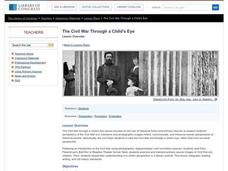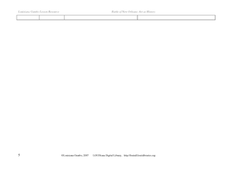Curated OER
Piecing Together the Story of Glenn Cunningham: A Kansas Champion
Students use primary and secondary sources to conduct research about Glenn Cunningham. In this Glenn Cunningham lesson plan, students tell why he was a hero, and tell facts from what they learned.
Curated OER
King David
Here is a quick instructional activity on King David, the second king of Israel. It discusses his famous contest with the Philistine warrior Goliath and is followed by a few reading comprehension questions.
University of California
The Civil War: Final Assessment
Pupils discover the true nature and purpose of the Civil War in the eighth and final installment of an informative series. Using primary and secondary documents, history buffs merge social study knowledge with English skills to create a...
Curated OER
A MATTER OF PERSPECTIVE: COLUMBUS IN THE NEW WORLD
Eighth graders study the famous explorer Christopher Columbus. In this World History lesson, 8th graders analyze and compare primary and secondary sources. Students discuss as a class the accomplishments of Columbus.
Curated OER
The Civil War Through a Child's Eye
Learners use primary and secondary sources to observe a child's view of the Civil war. In this Civil War lesson, students understand that different people had different perspectives on the war. Learners recognize the difference between...
Curated OER
Cabeza de Vaca Meets the Coahuiltecans
Seventh graders examine Cabeza de Vaca's journal and differentiate between primary and secondary sources. They, in groups, design posters that portray the culture of the Coahuiltecan Indians in Texas during the 16th century.
Curated OER
World War I: Letters from the Front
Students reesearch life on the home front and the front lines during World War I. They use primary and secondary sources to write letters. Students role-play as soldiers writing letters home and then assume the role of the person...
Curated OER
Critical Reading, Imaginative Writing and the Montage
Students discuss the difference between primary and secondary sources and consider how an exhibit is researched. They design and create a montage that reflects themselves in a social and historical context.
Curated OER
Why the US Fought and Lost the Vietnam War
Students examine the role of the United States in the Vietnam War. In this Vietnam War lesson, students research primary and secondary sources to find out why the United States was involved in the war and why it was unsuccessful in the war.
Curated OER
How Hard Were the Times? Investigating the Meaning and Significance of the Great Depression
Students examine causes and effects of Great Depression and its significance on twentieth-century life, analyze value of various types of historical information, specifically primary sources, and relate events, issues, problems, and...
Curated OER
History Did Happen in My Back Yard!
Eighth graders interpret historical evidence presented in primary resources. In this Louisiana history lesson, 8th graders research their parish history using the LOUISiana Digital Library resources. Students create multimedia...
Historica-Dominion Institute
Artifact Creation Activity
Creating an artifact that is representative of a specific time period provides an opportunity for amateur historians to understand the importance of primary sources. This resource describes the process for students to explore original or...
Curated OER
Roughing It in the Backwoods
Students have the opportunity to practice research and essay-writing skills using primary and secondary source materials. They explore aspects of early settlers' lives in the backwoods of Upper Canada.
Curated OER
Child Labor in America
Students interpret historical evidence presented in primary and secondary sources. In this child labor lesson, students examine the issue of child labor and determine how citizen action prompted...
Curated OER
Feminism Does Not Have to be an F-Word
Students analyze social activism messages in music. In this feminism instructional activity, students explore selected music that expresses sentiments voiced in the women liberation movement in the United States. Students compare the...
University of Arkansas
Promises Denied
"Promises Denied," the second instructional activity in a unit that asks learners to consider the responsibilities individuals have to uphold human rights, looks at documents that illustrate the difficulty the US has had trying to live...
Gilder Lehrman Institute of American History
Women's Suffrage: 140 Years of Struggle
Young scholars create PowerPoint presentations about women's suffrage. In this women's rights instructional activity, students use primary documents to study the women's suffrage movement. In pairs, young scholars create a PowerPoint...
Curated OER
Not Getting the News about the Stamp Act
How did American colonists react to the Stamp Act of 1765? Your young historians will examine primary source material by reading excerpts from a transcription of the Pennsylvania Gazette and then identifying the sentiments expressed by...
Gilder Lehrman Institute of American History
Slave Narratives: Frederick Douglass, Harriet Jacobs, and the Columbian Orator
Young historians practice in-depth, quality analysis of primary source texts in this three-lesson unit, which examines excerpts from the slave narratives of Frederick Douglass, Harriet Jacobs, and Caleb Bingham.
Miami-Dade County Public Schools
Honoring All Who Served Veterans Day
November 11th, Veterans Day, is a holiday set aside to honor all those who have served in the military. Here's a resource packed with ideas, activities, projects, and materials that will provide inspiration for ways to celebrate those...
Library of Virginia
Life as a Liberated People
Imagine having no control over your life and then suddenly having to provide for yourself. Such was the challenge faced by many American slaves after emancipation. Class members are asked to consider these challenges are they examine...
Stanford University
Great Plains Homesteaders
"Westward, ho!" may have been their cry in spite of the hardships. Using a series of photographs by Solomon D. Butcher of those who ventured west, class members consider what life was like in the 1800s for those who embarked on the...
Museum of the American Revolution
Object Observation: Purpose on a Powder Horn?
Young archeologists discover the significance of ordinary objects from the past in an interesting lesson on artifact analysis. The activity focuses on examining the image of a powder horn from the Revolutionary War to understand what it...
Curated OER
VA Statute for Religious Freedom, III
Students analyze the Virginia Statute for Religious Freedoms and consider its implications. In this governing principles lesson, students explore primary and secondary sources regarding the document penned by Thomas Jefferson.
Other popular searches
- Primary and Secondary Sources
- Primary Secondary Sources
- Primary vs Secondary Sources
- Primary & Secondary Sources
- Primary, Secondary Sources
- Teaching Secondary Sources
- Primary vs. Secondary Sources

























